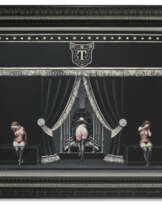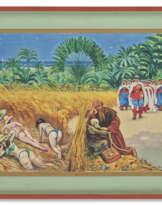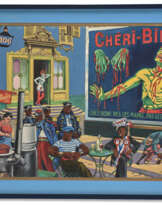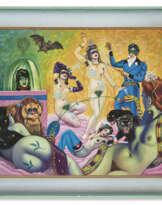ID 1304226
Lot 27 | Clovis Trouille (1889-1975)
Estimate value
€ 70 000 – 120 000
L'Oasis ou Odalisque
signé 'Clovis Trouille' (en bas à gauche); signé et inscrit 'L'Oasis Clovis Trouille 57 Avenue Mathurin Moreau Paris 19è ' (au revers)
huile sur toile dans le cadre de l'artiste
Image: 60.3 x 73.5 cm.
Cadre de l'artiste: 72.3 x 85.2 x 5 cm.
Peint en 1942-43
signed 'Clovis Trouille' (lower left); signed and inscribed 'L'Oasis Clovis Trouille 57 Avenue Mathurin Moreau Paris 19è' (on the reverse)
oil on canvas in the artist's frame
Image: 23 ¾ x 28 7/8 in.
Artist's frame: 28 ½ x 33 ½ x 2 in.
Painted in 1942-43
Provenance
Atelier de l'artiste.
Puis par succession aux propriétaires actuels.
Literature
C. Prévost, Parcours à travers l'œuvre de Clovis Trouille, Arles, 2003, p. 151 (illustré en couleurs; détail illustré en couleurs, p. 5).
Exhibited
Paris, Musée des Arts d’Afrique et d’Océanie, Exposition Clovis Trouille, octobre 1999-janvier 2000 (sans catalogue).
Ostende, Museum voor Moderne Kunst, Clovis Trouille, mars-novembre 2002.
Further details
Dans une tente aux motifs colorés, entrouverte sur une oasis luxuriante, une femme allongée à même les tapis chamarrés, la poitrine nue elle s’évente et semble à travers ses yeux mi-clos nous lancer un regard alangui.
Cet « Oasis » est l’héritage d’un Orient fantasmé et sensuel que Trouille découvre à travers les films et les lectures de son enfance, dans une lettre à ses amis Maurice Rapin et Mirabelle Dors, il se décrit comme un « ancien lecteur enthousiaste des Mille et une nuits ». Il déclinera ce thème dans plusieurs tableaux reprenant les poncifs du Moyen-Orient fantasmé : charmeuse de serpent (Femme au serpent, 1943) , harem, guerriers berbères, et danseuse du ventre (La danseuse du ventre au bordel, ou Courtisane arabe, 1942).
Trouille dans sa correspondance place son œuvre dans la continuité des Odalisques orientalistes du XIX° siècle, mais aussi de la peinture de Matisse dont il admire les talents de coloriste bien qu’il le critique sur la question du dessin préférant rester « académique » selon ces mots, car ‘quand, en effet, on déforme le dessin d’une femme, qu’on la «cubise», le sex-appeal s’en va et ces excentricités de dessin n’excluent pas la banalité.’ (Lettre à Maurice Rapin, 12 mai 1962).
In a colourful, patterned tent, opening out onto a lush oasis, a woman lies down on the multicolored carpets, with her naked breasts and bosom, as she fans herself and seems to languidly gaze at the viewer with her half-closed eyes.
In a letter to his friends Maurice Rapin and Mirabelle Dors, Trouille described himself as an ‘enthusiastic former reader of the 1001 Arabian Nights’. He returned to this subject in several paintings that tackled the clichés of the Middle East fantasy: such as the snake charmer (Femme au serpent, 1943), the harem, the Berber warriors and the belly dancer (La danseuse du ventre au bordel, ou Courtisane arabe, 1942).
In his correspondence, Trouille placed his work in the continuity of the Orientalist Odalisques of the nineteenth century, as well as of Matisse’s paintings. He admired the latter’s talent as a colourist, although he criticised him on the question of drawing, preferring a more ‘academic’ approach, as he explained in his own words: ‘When, in fact, one distorts the drawing of a woman, when one “cubicises” her, the sex appeal is gone and these eccentricities of drawing do not exclude banality’. (Letter to Maurice Rapin, 12 May 1962).
| Artist: | Clovis Trouille (1889 - 1975) |
|---|---|
| Applied technique: | Oil on canvas |
| Auction house category: | Paintings, Watercolors, Drawings, Paintings |
| Artist: | Clovis Trouille (1889 - 1975) |
|---|---|
| Applied technique: | Oil on canvas |
| Auction house category: | Paintings, Watercolors, Drawings, Paintings |
| Address of auction |
CHRISTIE'S 8 King Street, St. James's SW1Y 6QT London United Kingdom | |
|---|---|---|
| Preview |
| |
| Phone | +44 (0)20 7839 9060 | |
| Buyer Premium | see on Website | |
| Conditions of purchase | Conditions of purchase |














